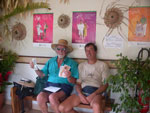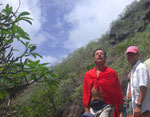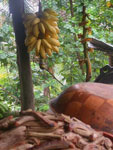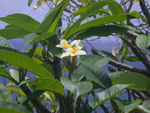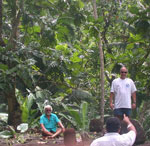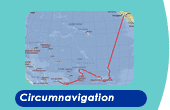April 16, 2002
|
Monday, our first full day at anchor after twenty-one days at sea, was mostly spent recuperating. The high point was finally linking up with our buddy boat, Makoko, and our friends Jean-Claude and Claudie. We had planned to meet them at a designated waypoint in the vast Pacific. Makoko would sail west from Cabo San Lucas and Pacific Bliss, south from San Diego. The winds didn't cooperate, so we had kept in touch via SSB, on our private Vin Rouge Net, twice each day. Having arrived in Hiva Oa first, Makoko already knew the ropes. Jean-Claude helped Gunter through the check-in process at the gendarmerie in the nearest town, called Atuona. Then we all went to the bank to get CPFs (they still have the Central Pacific francs as exchange, even though the Europeans have adopted the Euro). Jean-Claude then lined up an island tour for the next day. : Gunter and Jean-Claude at the bank in Atuona From there, we went to the only restaurant in town that was open, a big billboard saying SNACK, across the front, menu on a chalkboard, and self-service ordering, but great food. I ordered ginger chicken with rice. At 0830 Tuesday morning, all six of us were waiting at the concrete jetty, having secured our dinghies for the day. A red Toyota truck arrived with room for only three of us inside. Gunter sat up front next to our driver/guide, Sabine; Claudie and I sat in the backseat, while Jean-Claude, Armin and Doug climbed up into the back of the truck. That arrangement was just fine until the truck climbed up and up into the mountainous rain forest. The rain pounded down and the three in back began to take on the appearance of drowned rats. Ironman sat there, stoically, a small hint of a smile cracking his face; he was happy that this was a tropical rain, a far cry from the snows of his native Germany! Doug still had his big smile, treating this as just another adventure. But Jean-Claude looked miserable. His red knit polo was absorbing water big time. When we stopped at an orchard at the top of the mountain, he went to the back of the fruit storage shack, stripped it off, and tied Claudie's red scarf around his shoulders as a shawl. : Jean-Claude at the fruit shack We made our selections of fruit: a large bunch of green bananas, two packages of dried bananas, papayas, limes, and pamplemousse to be picked up on our way back. There is only one road to the Tiki Village; which is constantly under construction. It starts out as blacktop and ends up as gravel, a four-wheel-drive-only material. At one point, we stopped to move a large boulder out of the way. Photo 5628: The guys move a boulder off the road-their good deed for the day. The drive was a little hair-raising as the Toyota veered around the steep cliffs on one side, the sea far below, but the view was spectacular. The deep blue bays were serene and pristine. We did not see one vessel in any of them, until we reached the village. "Why not?" we asked Sabine. "It is not as calm as it looks down there," she said. "The shores are rocky and the high surf makes it all but impossible to get to shore anyway." : View of pristine bay. (coming soon) After the orchard stop, a Land Rover driven by Pepe, Sabine's husband, arrived and the two tour groups traveled together, stopping at various photo ops. In the other group were the captain and crew of Raven, a familiar name from the Puddle Jump Net. Pepe, a large, stocky Marquesan, told stories at each stop. He also taught us the Marquesan war chant, which we practiced periodically, feet apart and knees bent slightly, for a low center of gravity. We pulled our arms down fiercely in an Uh, Ooh chant, a comical sight in the rain, I'm sure. Both vehicles were stopped at a turn in the gravel road, tall rocky spires to our backs, steep cliffs leading down to an especially deep bay below. Pepe made it a point to explain to the assembled group that the true Bay of Virgins is right here-not in Fatu Hiva, to the south, an island we planned to visit. "In Fatu Hiva," he went on to say, "the missionaries changed the original spelling Bay des Verges-which means Bay of the Phalli to Bay des Vierges, which actually makes it worse, because now it means 'virgins on the rocks.' " "But right here," he pointed to a high table-like formation, "is a rock where virgins were actually sacrificed, and this bay below you is where they were thrown." Living up to my name, "Digital Lois," I walked around taking photos as Pepe talked. So I missed a few of the stories. Cannibalism was a prime topic. "The last cannibalistic ritual was performed in right in Hiva Oa, at Atuona," Pepe said. He seemed proud of his fierce ancestors. When the Marquesan girls go on to school in Papeete, he told us, they do not speak the Marquesan language; they speak only French, because they are reluctant to admit where they are from. But the boys are proud of their warrior heritage and call the native Tahitians the French equivalent of "wussies." When two tribes would fight, and upon the defeat of one, the winner would have the head of the vanquished foe cooked, then brought back to him. Then, in front of the foe's followers, he would first eat the lips (a sign of authority), then the eyes (to demonstrate vision) and lastly he would slowly open the skull and proceed to eat part of the brain. At that point he would take on the mental attributes of his enemy. This ceremony allowed the vanquished warriors to serve him as their king and they now followed him willingly. Back in the touring car, Sabine continued a lively conversation in French and English that she had learned by attending college in Fiji. Her twelve-year-old son sometimes accompanies them on tours and can repeat the stories his father tells. It's great to see that in at least one family, the traditional stories are passed on. Most modern day Marquesans, Sabine explained, are not interested in their history and legends. "How long have you been married?" Gunter asked. "Twenty years." "To the same man?" "Yes," she laughed. "Divorce is rare here. All the families are so close and help each other out. Most of them are related. There are only 2000 inhabitants on Hiva Oa. It's a small community. We stick together. In fact, there are only 8000-9000 in all of the Marquesas. "I read that there was a large population here at one time," said Gunter. "Yes. There were 50,000 to 80,000 during the pre-European era. Before they discovered us. At the low point there were only 800." "Wow! What happened?" "Syphilis, leprosy-there is still a colony here you know-elephantiasis, all brought by the so-called civilized white man. By 1926, a French doctor tackled the problem and reversed the trend." The sun came out off and on and I urged a stop every so often to wonder at the flora of the island. Sweet pale yellow frangipani overlooked the mountainsides. The guys picked them for Claudie and me. We made a show of placing the fragrant flower behind our left ears in the Polynesian style, signaling that we are happy and "attached." Delicate purple orchids held on tenaciously to the mountainsides while lupine-like blue spires lined the gravel road. "The leaves are used to treat bruises," Sabine explained. "And it works." Trees with yellow hibiscus-like flowers were everywhere. "They are called Pivinche de Madagascar," said Claudie. "We had them in Nigeria." I especially liked the fankata, a graceful flat-topped trees topping the mountains. They made one mountain we passed look like a flat-top haircut, another, a crown of thorns. The highlight of our tour was, of course, our destination: Iipona. The road would end at the famous archeological site at shore of Baie Puamau. But before we toured that it was time for a stop in the town. We stopped for refreshments-beer or cokes to take to our lunch if we wished-at the store owned by the great-grandson of Gaughin. Pepe pointed him out. There he was, plodding along on a great gray horse on the dusty main street, ponytail swaying, and a red bandana around his forehead-looking for all the world like a Polynesian Willie Nelson. Geared up by the timely appearance, Pepe started to tell us the story of the family as we stood there sweating under the penetrating noon-day Marquesan sun. When we noticed that our recently-purchased cold beers were sweating too, we all turned toward the trucks. Lunch was Marquesan, prepared in a thatched-roof greathouse with long tables set up especially for tour groups, outhouse outside. Serving was family style, with ample bowls of poi (made with pumpkin and very sweet, almost like a dessert), fried breadfruit (tasty, similar to French fries), Poisson Cru, Rice, Goat, Pork, Juice, and Tall Pitchers of water with ice (more on that water later). We sprayed on repellent and walked through the site. Takaii is quite impressive; it is the largest tiki in the world, standing at 2.43 meters (8 feet). He stands on a massive, stone-ringed terrace, with his wife kneeling submissively to his side and behind. "Still Life" of Claudie and Jean-Claude with Tikis The turtle, the god of fertility was also at the site, as well as a statue representing the "high priest". There was an area for the chief's councils, a "mating" area, etc. It was an unusually large center, Pepe said, because seven tribes used it. Pepe called up various tour participants as he attempted to re-enact what legends say happened there. Gunter was called upon to pose as the chief. Tired and thirsty, we had trouble staying awake following the same (and only) road back to the harbor. Unfortunately, I drank from the water bottle I had refilled from the water pitcher during lunch. I lost the entire next day to the Marquesan version of Montezuma's Revenge.
journal78.html |
|
|
|
